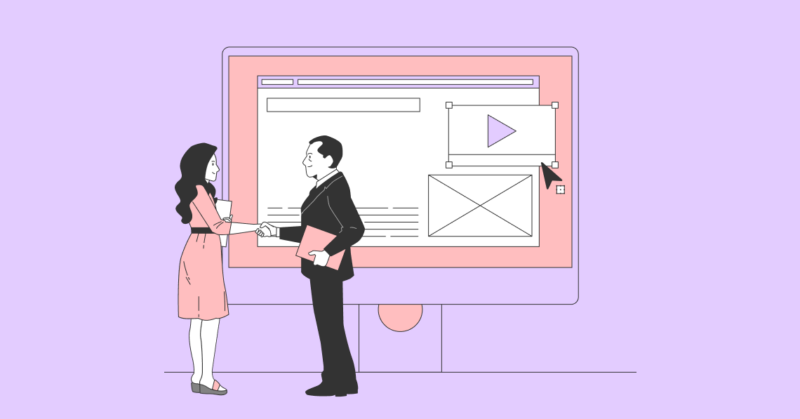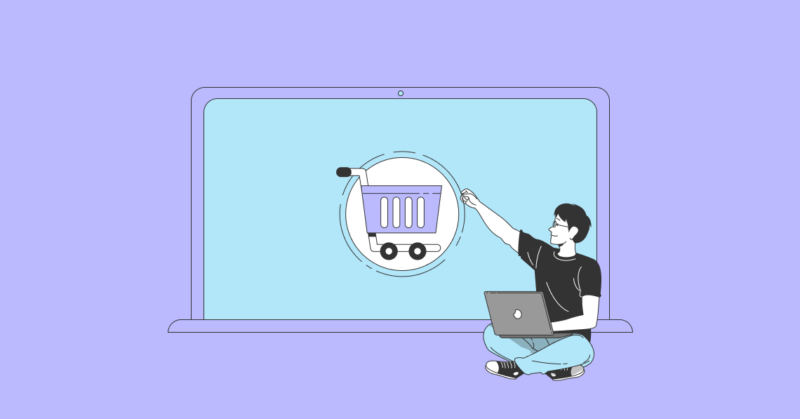您是否知道自1960年代以来已经存在电子商务?不,不是您现在想到的电子商务,但是肯定有可以追溯到这么远的电子数据交易。第一次在线零售交易发生在1994年,认为在不到20年的时间里,电子商务已成长为一种自然的生活方式。根据美国商务部的数据,截至2020年第3季度,美国所有零售销售额的14.3%是电子商务销售。
But what is eCommerce, really? Who engages in eCommerce? What business can happen over the internet? In this article, we're going to cover everything you've ever wanted to know about eCommerce, platforms, business models, and give you a quick rundown about how you can start your own eCommerce business. Let's start with a quickdefinition of eCommerce。
What Is eCommerce? - The Definitive Guide:
What Is eCommerce: A Definition
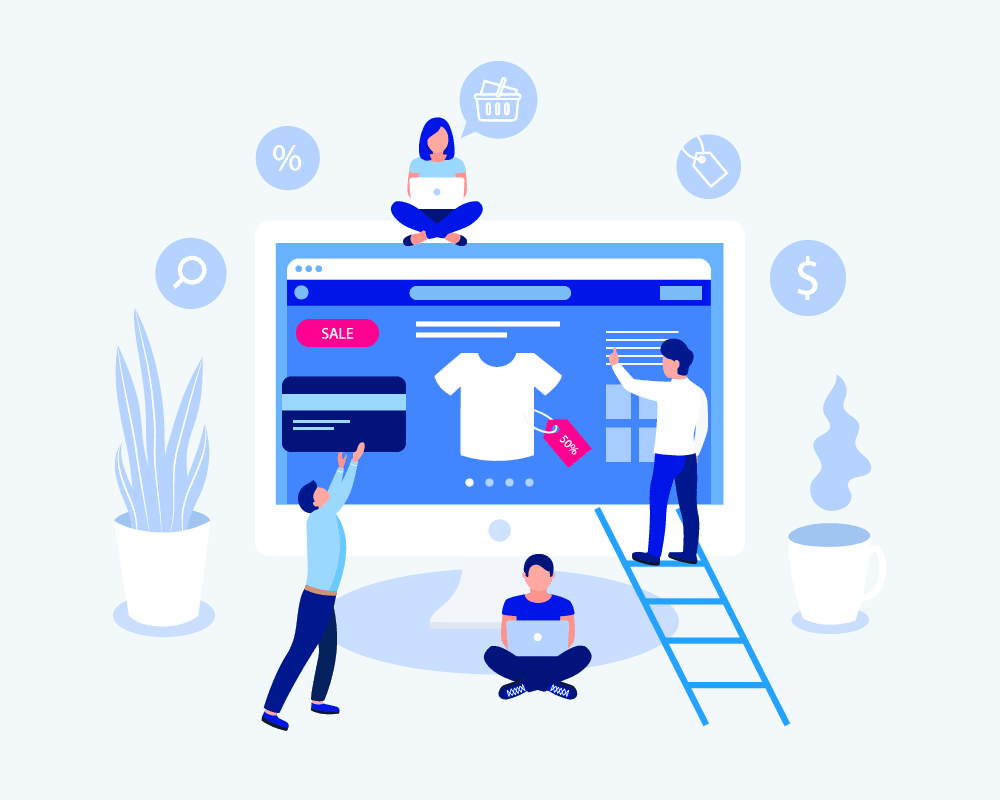
电子商务或电子商务包括在互联网上发生的任何交易。因此,消费者或企业在线购买和销售产品或服务的任何时间都可以从事电子商务。不过,这不仅包括购买和销售产品和服务。它还包括诸如互联网银行,在线门票,在线拍卖和支付网关之类的东西。
电子商务类型
There are quite a few different ways to classify eCommerce businesses based on what they sell. Let's take a look at some of the products and services typically sold online.
实物
This is usually what people think of when they think of eCommerce. Consumers can buy physical goods like clothing, accessories, furniture, tools, and more through online stores' websites—just add your desired product to your virtual shopping cart and complete your purchase. Then, the item gets delivered to your door or sometimes you can go pick up from the store.
数字产品
Digital products like ebooks, movies, online games and other software, andonline coursesare another classification of eCommerce. These products are known as e-goods.
服务
服务也可以在线购买。从自由职业者和顾问到在线教师到商业或生活教练,您可以通过电子商务购买的任何东西。有时,可以直接购买服务,例如通过市场。不过,其他服务提供商要求您首先预订咨询,以确切确定您的需求。
Different Types of eCommerce Businesses
尽管电子商务业务有三个基本分类,但每个分类中也有不同类型的电子商务。这里有些例子。
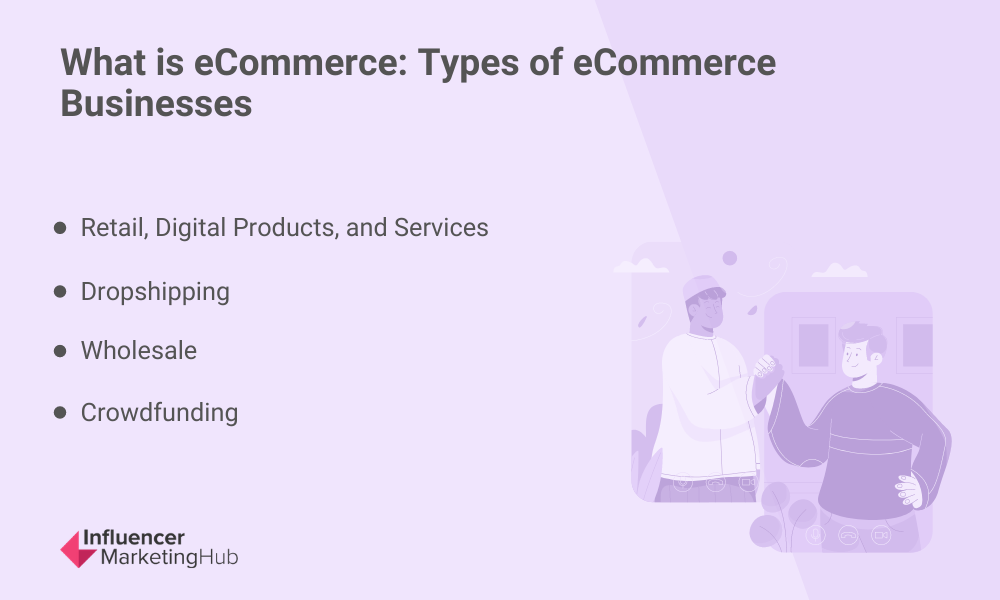
- 零售,数字产品和服务。Products, digital or physical, or services are sold directly to the consumer who's ostensibly going to use them. This includessubscription-based businesses, too.
- Dropshipping.这是使用第三方出售生产和运送给消费者的产品。
- Wholesale.This is typically a B2B business where wholesale products are sold to a retailer who then sells the products to their consumers.
- Crowdfunding.Sellers use crowdfunding to raise startup capital to bring their products to the market. So, once enough people have purchased the product, it gets created and shipped.
谁参与电子商务?
Now that you know about the classifications and types of eCommerce businesses, it's time to find out who's involved in these eCommerce transactions.
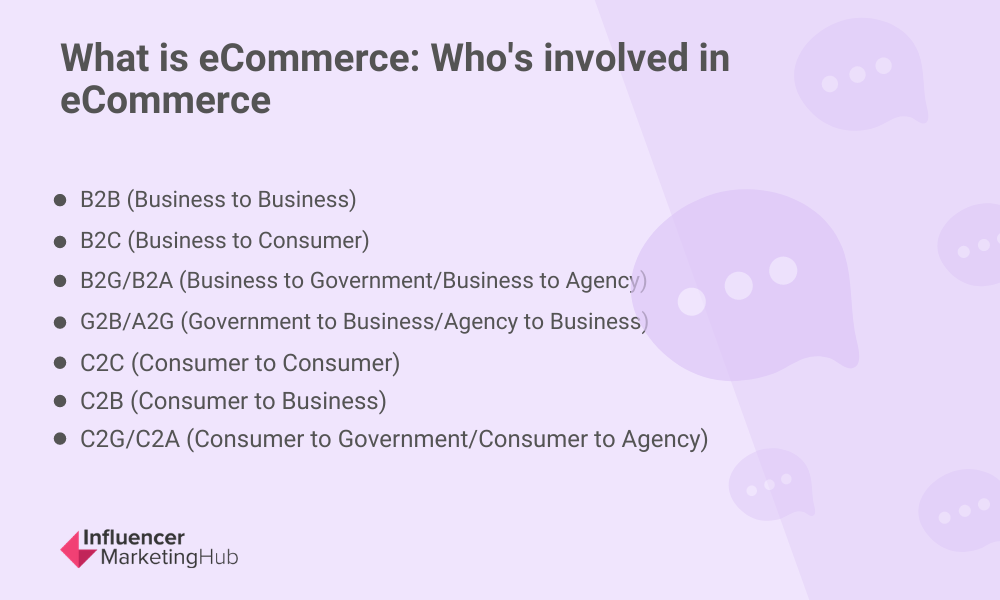
- B2B (Business to Business).在此模型中,企业向其他企业出售。
- B2C(对消费者的业务)。B2C模式包括企业之间的交易sses and individuals.
- B2G/B2A (Business to Government/Business to Agency).In this model, businesses are providing products and services to the government.
- G2B/A2G (Government to Business/Agency to Business).这与B2G模型相反,在该模型中,政府为企业提供产品和服务。
- C2C(消费者对消费者)。Both sides of these transactions are consumers. Business that happens on Craigslist or online auction sites like eBay are examples of the C2C business model.
- C2B(企业消费者)。In the C2B business model, individual consumers create value for businesses. This might mean consumers cooperating on projects with a business (user-generated content, for example) or a freelancer providing a service.
- C2G/C2A (Consumer to Government/Consumer to Agency).如果您缴税,您将参与这种商业模式,消费者支付税收或任何涉及公共部门的行动之类的事情。
The majority of the time, when people talk about eCommerce, they're talking about the B2B or B2C business model. However, it's nice to know that other business models exist.
电子商务的优势和缺点
像一切一样,电子商务既具有优势又具有缺点。在本节中,我们将分享双方的一些最大要点。
Disadvantages of eCommerce
- Data security breaches and credit card fraud is a regular occurrence.
- Consumers don't always complete their online purchases (invest in an电子商务平台or email marketing service that lets you send abandoned cart recovery emails).
- While reach is huge with online businesses, you can't reach everyone (only about25%of the world shops online).
- 虽然您的间接费用将少于物理供应商,但您仍然需要用于网站托管,您的电子商务平台,信用卡费用,营销,存储和运输的费用,更不用说税收,许可证和其他费用了。
- Competition is high.
- 购物者想要亚马逊级服务和运输,这对于小而很难电子商务businesses。
- It can be difficult to build customer relationships due to limited interactions.
电子商务的优势
- 比实体商店低的间接费用要低,因为您没有实体位置,额外的公用事业成本,租金和其他服务。
- Businesses can scale quickly since you can add and remove products or services as you desire.
- Make sales 24/7 since you don't have to staff a location.
- Reach more customers while living where you want to live.
- 跟踪销售和货物很容易做到。
- When you use the right eCommerce platform, it's really easy to compile customer data to改善营销。
How to Get Started in eCommerce
As you can see, there's a lot to consider. But if you're ready to jump in and start your own eCommerce business, keep reading for a quick overview on how to get started. Check out our article如何开始电子商务业务for an in-depth overview. Let's dive in!
Step 1. Choose Your Business Idea
The first step to starting your eCommerce business is to figure out what products or services you're going to offer. You'll want to find an idea that's scalable and is also going to bring in the kind of money you need. Here are a few different ways you mightfind the right eCommerce business idea:
- 解决问题。思考一个问题你想帮助人们求解e.
- Sell niche products.Everyone has a hobby. Think about a particular hobby you can provide products or services for.
- Your own experience.你最喜欢做什么?考虑一下您可以销售和销售已经拥有的技能的方式。
步骤2.采购
If you're selling physical products, you're going to have to find a way to source or manufacture your products so you can sell them. One of the easiest ways to do this is dropshipping since you won't have to have storage for your inventory or even worry about shipping your orders. You're essentially the retailer connecting the product supplies to the customers. Many dropshipping companies even handle all of thecustomer service。
If you don't want to go the dropshipping route, you can resell from wholesalers. To do this, you'll be buying products from a wholesaler that you then resell to your customers at a higher price. This means that you'll be putting the money out upfront, keeping an inventory, and shipping on your own. Plus, you'll be handling customer service, too.
如果您有自己想出售的产品,则可以与制造商联系以大规模生产产品。再一次,这意味着您将预先将资金放在产品上,保留库存,并自己处理运输和客户服务。但是,您将出售您想出的产品。
Step 3. Creating a Brand
After you've figured out the problem you're going to solve and how you're going to get your products into the hands of the people who want them, it's time to create your brand.Branding不仅涉及徽标和颜色。在执行此操作之前,您需要找到您的unique selling proposition并决定将为您工作的业务结构。
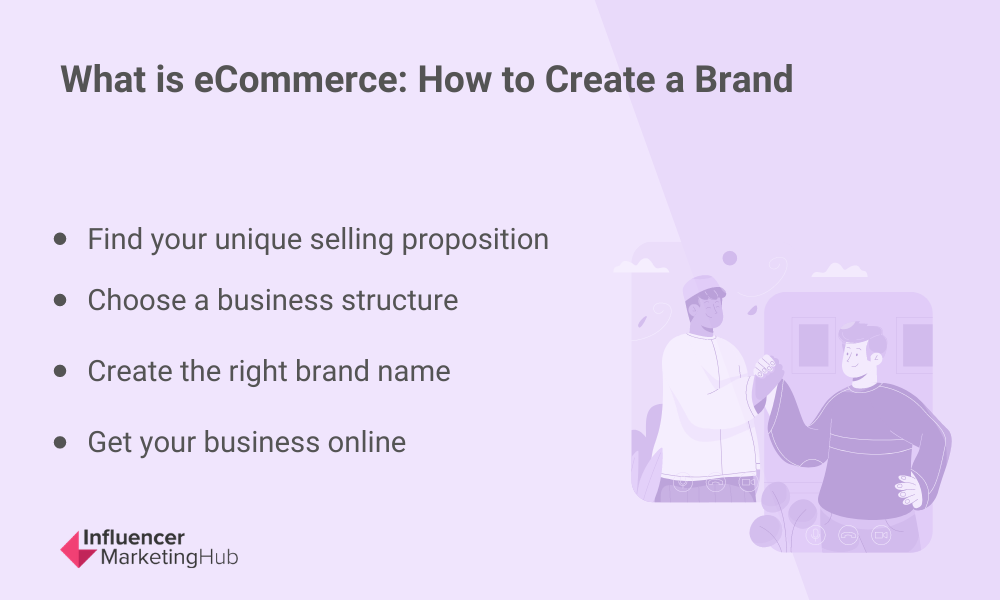
Unique Selling Proposition
Your unique selling proposition is what sets you apart from your competitors and shares with your customers how you can provide value and benefit them. Your unique selling proposition will be apparent through all of your branding and marketing campaigns. You can narrow down your USP by making a list of your business' strengths and how you help your customers. From there, get rid of anything that's generic and hone in on the ones that are specific and niche.
Business Structure
Your business structure addresses legal and tax issues for your business. Limited liability companies (LLC) and sole proprietorships are the most common for eCommerce businesses. Forming an LLC offers some protections because the company is separate from the owner legally and for tax purposes. Sole proprietorships are a more informal structure in which business taxes are filed under the business owner's personal tax filing. If you're planning on having a large customer base, you'll probably want to opt for an LLC.
Brand Name
Your brand name should be simple, just a word or two, and should let customers know a bit about your brand's personality and what they can expect from doing business with you. Naming a brand is hard work. There are many great品牌机构这可以帮助您找到业务的完美名称。并确保尚未采用。
领域
Once you have your brand name, you're ready to register a domain. Your domain name should be memorable and easy to pronounce. It doesn't have to be the same as your brand name, but it really makes sense to do that. Also, it's easy to get carried away with all of the extensions available these days. Your best bet is to stick with a .com domain.
电子商务营销趋势
电子商务有点像破坏者。这意味着它改变了人们购买的方式以及企业与客户互动的方式。而且它只会从这里增长。让我们看一下我们可以期望看到更多的电子商务趋势。
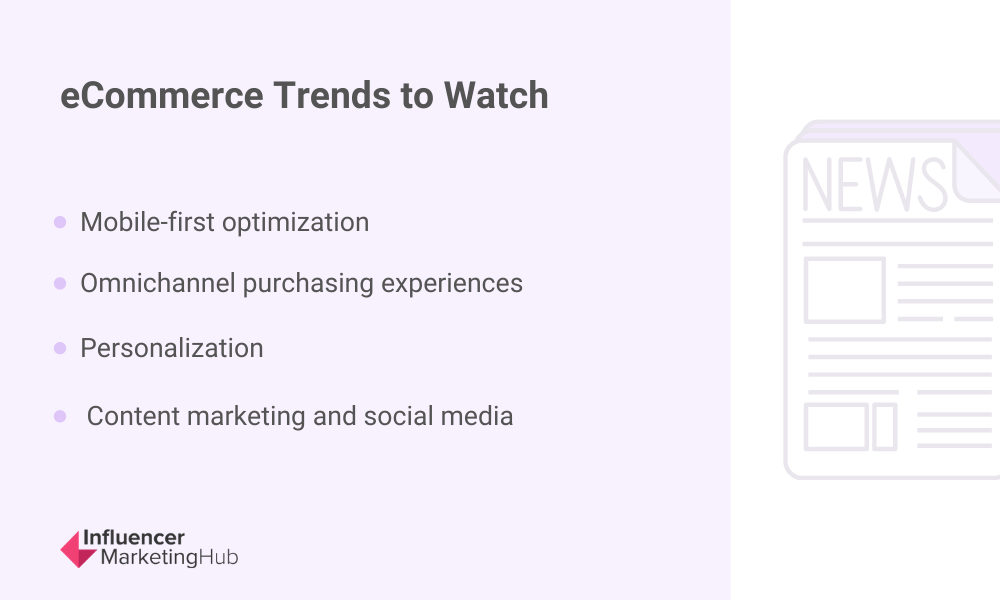
移动优化
在过去的几年中,移动设备上的在线订购有所增加,据估计,移动商务将考虑到44% of eCommerce sales到2025年。这意味着为移动优先用户优化您的电子商务平台对于保持这些客户的参与和快乐将很重要。专注于创建一个mobile-first website design,帐户在您的移动购物者中帐户marketing funnelsand consider different payment gateways that allow shoppers to use things like Google Wallet and Apple Pay.
Omnichannel Purchasing Experiences
Omnichannel eCommerce means that customers will have a seamless shopping experience no matter where they're shopping—phone, mobile device, computer, in-person. This might mean using cookies to track what your website visitors are looking at and then using重新定位运动to bring them back into your online store or using past purchase behavior to inform the ads and promotions your customers see. Providing these customized, seamless experiences goes a long way towards increasing customer loyalty.
个性化
As you can probably tell from the first two trends,personalizationis the watchword. Your customers are individuals and want to be treated as such. Businesses will need to find new ways to track customer behavior to better understand them and offer them better, personalized experiences. This might mean using dynamic content to customize website and email content so you can show shoppers information customized to their behaviors and interests.
内容营销和社交媒体
Content marketingand社交媒体市场营销aren't going anywhere. eCommerce businesses will continue to use content to drive traffic as well as engaging, educating, and entertaining their customers while delivering powerful calls to action that will push them to make a purchase. Social media will continue to grow as a way for brands to connect with their customers and develop relationships. More and more brands will turn towardssocial media influencersto capitalize on consumer relationships and drive more sales.

